The history of the church
Contributed by H.J. Carr, B.D.
The General Baptist Church, Ovenden
Inception. Many of the Churches of the New Testament owed their origin to blasts of persecution, for “They that were scattered abroad went everywhere preaching the Word.” Our first Church, at Ovenden, sprang as a root out of the dry ground of adversity. In the year 1845, as a result of the introduction of mechanical power, hand-loom weaving declined to such an extent that several families dependent upon it for their livelihood were compelled to leave their native places and take up residence in Ovenden. Amongst these were several families from the General Baptist strongholds at Heptonstall Slack, Birchcliffe and Queensbury. Settled in their new home, this little company of those that feared the Lord spake often one with another, meeting together for prayer, and inaugurating a Sunday School in a cottage at Sod House Green, Ovenden. In the year 1846 they formed themselves into a General Baptist Church.
Constitution. No bond of covenant is extant. The initial membership was 33, of whom two came from Birchcliffe and 13 from Heptonstall Slack. Hy. Cockroft, J. Marshall, Z. Greenwood and George Hellewell were the first Deacons, and in 1853 mention is made of Jacob Moore as Secretary, Henry Cockroft as Treasurer.
Activities. The earliest records in our possession (1853) shew that the Church conscientiously and fearlessly exercised disciplinary powers over her absenting and offending members. By this time the membership had increased to 44. The need was felt for some Lord's Day Evening Service in the district, so the Church instituted experience meetings, held in the cottage of Ann Hartley. More commodious premises were occupied in August, 1854, the cottage at Sod House Green being vacated and the Church transferred to the Temperance Hall, Nursery Lane. The following December a further removal was made to the Moorside School, belonging to Jeremiah Stead.
The tide, however, had commenced to ebb; various experiments were tried so as to revive the experience meetings, visitation was carried out, but with no success. In the minutes of a special Church meeting in March, 1856, we find the dismission of certain members to other Churches and the erasure of others from our own roll. The following month they record that “All our supplies having given up attending but Jacob Moore, agreed to employ him as our regular minister.” An effort was made in May to commence a weeknight prayer meeting. This is the last recorded resolution of the Church. The next year the Church had ceased to exist.
The Ministry of the Child
The period between the dissolution of the old and the formation of the new “Branch Church” at Ovenden is dealt with in the history of the Sunday School, sufficient is indicated here only to make connection between the two periods.
Certain members, having transferred their membership to North Parade, remained at Ovenden to conduct Sunday School work. Preaching Services were maintained, the pulpit being supplied through aid from North Parade. This help was withdrawn in 1862. The following year an unsuccessful appeal for affiliation was made to North Parade, whereupon a meeting was convened to consider the expediency of closing the School. Before the meeting was dismissed a scheme for the building of larger premises was launched. Out of the expiring embers the Spirit of God kindled a living flame. “Ere the lamp of God went out in the Temple of the Lord... the Lord called Samuel.” So it was with us as when “The child Samuel opened the doors of the House of the Lord.”
The Branch General Baptist Church, Ovenden
The wisdom of continuing was justified by her children. During the next three years the membership increased from 10 to 21. Permission was granted by North Parade Church for the ordinance of the Lord’s Supper to be administered in our own School premises. In 1869 a building site was purchased at Bank Top, and on March 24th, 1872, service was conducted for the last time in the old preaching room at Moorside. On March 29th the new premises were opened.
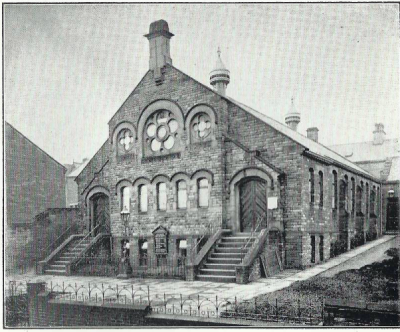
The relation between the school and the church during this period is of interest. In the records of a meeting of teachers and senior scholars held in April. 1866, there occurs the phrase “We, as a Church and School.” As yet there is no separate Church meeting, the School meeting legislates for the Church. That the School aimed at being ultimately an independent Church is seen from the same record, which states that Hy. Townsend, Thos. Clegg, Wm. Wilson, Thos. Sunderland and Wm. Oswin were appointed to negotiate with North Parade to secure recognition as a branch, but it was stipulated that the arrangements must be such as would promote their aim towards a new building and a separate Church.
This affiliation was effected. The School-Church became recognised as a Branch Church of North Parade, and in a subsequent minute is referred to as “The Branch General Baptist Church, Ovenden.”
The Branch Church, Bank Top
Hitherto the Church had been in apartments; now it possessed a home of its own. The Opening Services were held on Good Friday, March 29th, 1872, the Rev. T. Goadby, of Derby, preaching afternoon and evening. The membership at this time was 25.
The status of the church. What was its relation to the School, through whose instrumentality it had come into being? The superior authority of the Church can be seen from two facts :— (1) The Church charged the School a rental of £10 per annum. (2) The records of business meetings no longer bear the heading “meeting of teachers and senior scholars,” but “Church meeting” or “meeting of members.”
As a “Branch Church” certain rights were held, certain powers withheld. The guardianship was sustained by the North Parade Church. In acknowledgment of our obligations a contribution was made to the funds of the Parent Church. The minutes of this period frequently refer to our Church as “The Branch.” A committee consisting of Thos. Clegg, Wm. Wilson and John Ackroyd was elected in place of a diaconate. Henry Townsend acted as representative to the diaconate of North Parade, which privilege was further extended in 1877, when two representatives, John Ackroyd and Wm. Oswin, were elected.
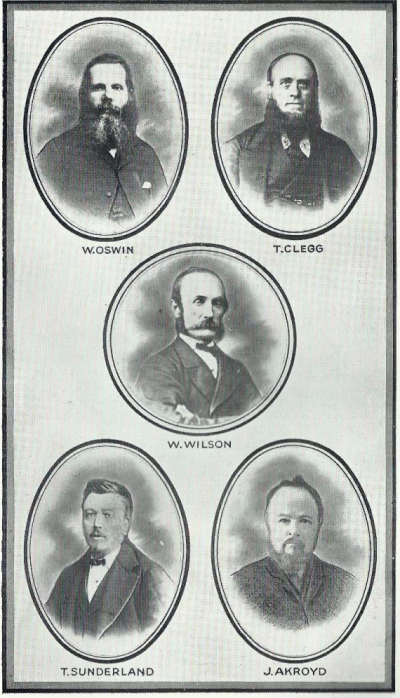
“The Branch” held its own Church meetings, presided over by the minister of North Parade, to whom reference is constantly made as “our pastor.” These meetings had power to appoint visitors and report to North Parade, interviews with candidates, but not to accept them. The latter was done by the Parent Church, through whom also transfers to and from other Churches were authorised. Candidates were baptised in our own School-Chapel by the minister of North Parade, the first baptism being on April 28th, 1872. The right hand of fellowship was usually extended by the minister, though occasionally by lay preachers.
During the decade 1878--88 strenuous and successful efforts were made towards the removal of the debt. A sufficient balance remained in hand to permit of the ventilation and re-decoration of the premises. The spiritual activities of the Church were not abated. As the debt diminished the membership increased. In 1877 there were 71 members; 1889 there were 141. These accessions were largely the result of evangelistic campaigns. During one year alone there were 31 baptisms, of which 24 were from the School. The oversight of the Rev. W. Dyson, pastor of North Parade, resulted in the addition of 100 members to our roll.
Independence
The first definite token of aspiration after an independent existence was the decision in 1890 to launch a “minister’s fund.” At the close of the following year a letter was read from the Parent Church containing proposals for separation. The suggestions offered were that the Branch Church (1) keep its own register of members; (2) have power to give and accept transfers on own initiative; (3) have power to receive candidates for baptism without consultation with North Parade; (4) take necessary steps for becoming “a separate and independent Church.” The reasons which commended this course are given as four (1) the unanimous feeling of the Church that the present is the most opportune time; (2) with the present year our Conference and Association as General Baptists virtually ends in consequence of the amalgamation of Baptist Churches; opportunity is afforded for affiliation with other Churches of the Yorkshire Association; (4) the good feeling existing between North Parade and us, and their confidence in us to manage our own affairs.
The Church unanimously accepted this charter of “Home Rule,” and on Good Friday, April 15th, 1892, special meetings were held and the Church was formed into a separate body.
The Lee Mount Baptist Church
therefore dates from 1892. Its first membership was composed of 134 members, whose names were transferred from the North Parade Church. The diaconate consisted of H. Townsend, J.H. Hooson, Wm. Wilson, J. Naylor, Chas. Jacobs and J.H. Holroyd. J.H. Hooson was appointed to the secretariat, Jas. Naylor to the treasurership. In that same year the Church proceeded to strengthen its ropes by affiliation with the Yorkshire Baptists’ Association and the Halifax Nonconformist Council.
The Pastorates
| The Rev. | J.H. Robinson | October | 1893 to | August 1898. |
| " | D.B. Davies | December | 1899 " | November 1905. |
| " | F.W. Duncombe | August | 1906 " | August 1911. |
| " | J. Brown | September | 1912 " | February 1919. |
| " | H.J. Carr, B.D. | August | 1919 |
All these brethren are still in the ministry, our first pastor sharing with the present pastor the services of this Jubilee.
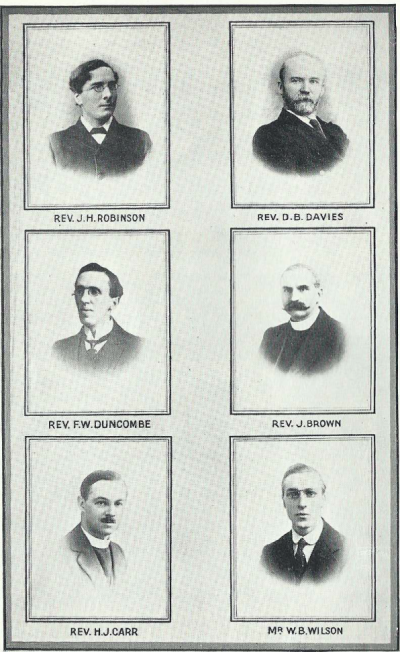
It has been our solemn duty and privilege to set apart for the work of the Christian ministry, Mr W.B. Wilson, one of our members, who entered Rawdon Baptist College in 1919.
The New Chapel
The growing cause necessitated the erection of larger premises. A new Building Fund was opened in 1897. Ten years of strenuous effort and sacrificial giving paved the way to the commencement of the work. The first sod was cut on April 6th, 1906, and on 1st June the first stone was laid. The building completed, the opening ceremony was performed by Mrs. Enos. Smith on 30th May, 1908. The first sermon in the new Chapel was preached by the Rev. J. Moffat Logan. At the close of the opening services it was announced that towards the total cost of £4,360 the sum of £2,650 had been obtained. By 31st December, 1914, the debt had been expunged.
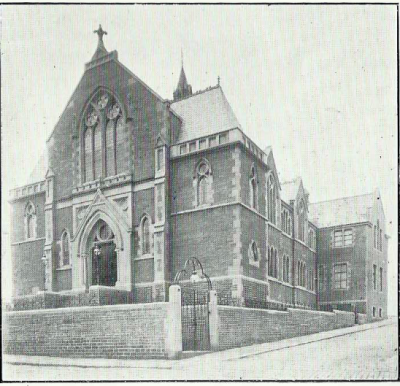
Great Thanksgiving Services were held on January 16th and 17th, 1915, sermons being preached by Dr Haslam, of Harrogate, Revs. F.W. Duncombe and J. Brown. A public meeting was held, presided over by Mr Enos Smith and addressed by Messrs H. Townsend, J.H. Hooson and Wm. Bradley. The untiring secretary throughout the whole of this strenuous effort was Mr Clement Hoyle.
All these brethren are still in the ministry, our first pastor sharing with the present pastor the services of this Jubilee.
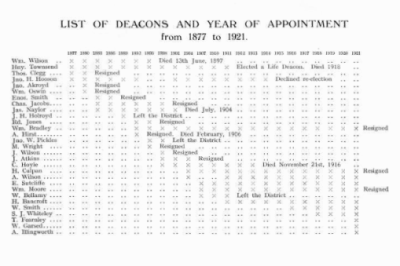
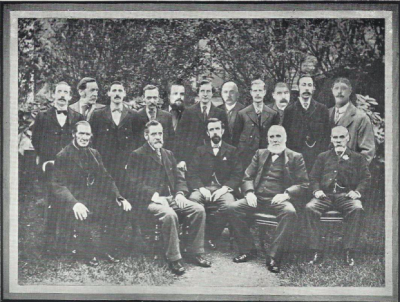
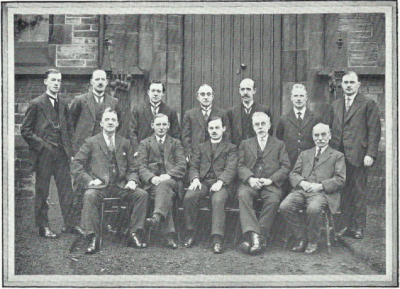
The Manse
The shortage of houses that followed in the aftermath of the war necessitated the purchase of a manse by the Church. Early in 1921 we had the offer of Shrogg’s Villa, then for sale. This the Church decided to accept, and the purchase was effected for £425. This was made possible by loans granted by friends. The discharge of these liabilities has been made one of the objects towards which our £1,000 Jubilee Fund will be directed. The manse is a very desirable property and is situated in the vicinity of the Chapel.
The Memorial Organ
The lack of an Organ suitable to lead our worship in song has been a long felt handicap. Those who by their sacrifices bequeathed to us the Chapel cherished also in their hearts the fond desire to install therein an Organ worthy of such a House. In fulfilment of their dreams, and in fragrant memory of “our boys” who fell in the Great War we are zealous to erect such instrument. It was felt no more opportune occasion of appeal for the financial side of this undertaking could be made than that furnished by the “Family Gathering” associated with our Jubilee Celebration.